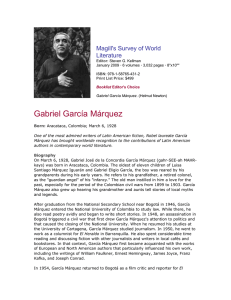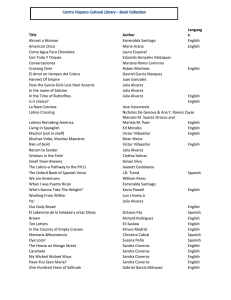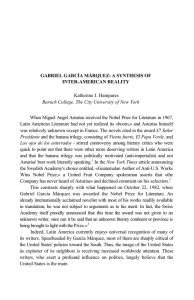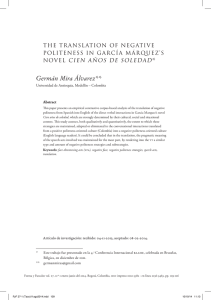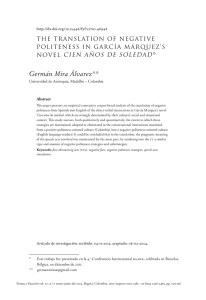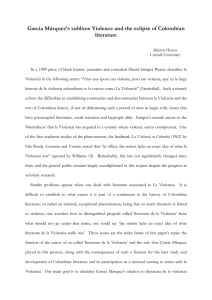REVIEW / CRITICA Living to Tell the Tale1 Gene H. Bell
Anuncio
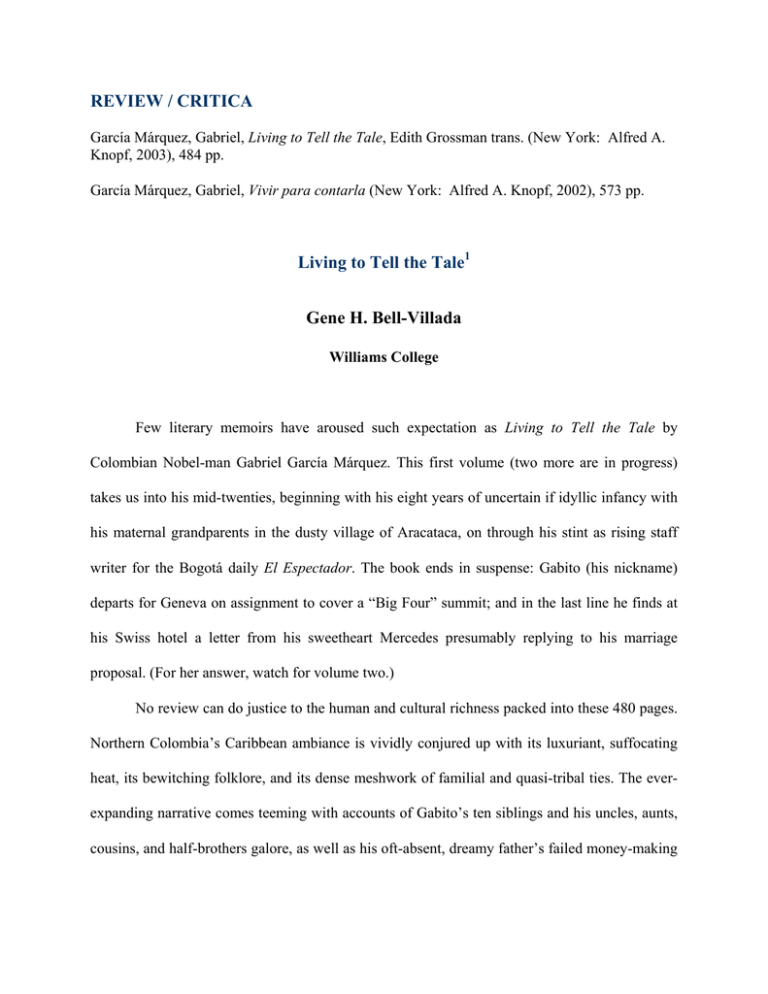
REVIEW / CRITICA García Márquez, Gabriel, Living to Tell the Tale, Edith Grossman trans. (New York: Alfred A. Knopf, 2003), 484 pp. García Márquez, Gabriel, Vivir para contarla (New York: Alfred A. Knopf, 2002), 573 pp. Living to Tell the Tale1 Gene H. Bell-Villada Williams College Few literary memoirs have aroused such expectation as Living to Tell the Tale by Colombian Nobel-man Gabriel García Márquez. This first volume (two more are in progress) takes us into his mid-twenties, beginning with his eight years of uncertain if idyllic infancy with his maternal grandparents in the dusty village of Aracataca, on through his stint as rising staff writer for the Bogotá daily El Espectador. The book ends in suspense: Gabito (his nickname) departs for Geneva on assignment to cover a “Big Four” summit; and in the last line he finds at his Swiss hotel a letter from his sweetheart Mercedes presumably replying to his marriage proposal. (For her answer, watch for volume two.) No review can do justice to the human and cultural richness packed into these 480 pages. Northern Colombia’s Caribbean ambiance is vividly conjured up with its luxuriant, suffocating heat, its bewitching folklore, and its dense meshwork of familial and quasi-tribal ties. The everexpanding narrative comes teeming with accounts of Gabito’s ten siblings and his uncles, aunts, cousins, and half-brothers galore, as well as his oft-absent, dreamy father’s failed money-making schemes and his once-rebellious mother’s heroic efforts at creating order amid domestic chaos. Add to the clan Gabito’s succession of many friends and colleagues and you get a cast of characters in the hundreds, each of them recalled and fleshed out by the novelist with loyalty and loving care. Among the major subjects relived here is the special relationship enjoyed by little Gabito with his maternal grandfather, Colonel Nicolás Márquez, a close bond that will shape the rest of the growing boy’s existence. In addition there are the inevitable accounts of adolescent sexual escapades in and out of brothels, and later of his being shipped out to lonely, distant boarding schools and the Universidad Nacional. The large forces of public history intrude, and not just as backdrop: local political feuds big and small, the sinister and corrupting presence of the United Fruit Co., and the vast, apocalyptic Bogotá riots of April 9, 1948 (Colombia’s “9/11,” as it were), in which thousands died and the entire downtown area was laid to waste. Along the way we get a concrete feel for the towns where young Gabito dwelled—sleepy and impoverished Aracataca, gossip-ridden Sucre, entrepreneurial Barranquilla, chill and proper Bogotá, and the dazzling beauty of colonial Cartagena. Permeating all events is Gabito’s slowly growing vocation as a writer. From the book’s very start in medias res we see his worried mother confronting the 20-year-old dropout, urging him to return to his law studies rather than cling to some scantily-paid scribbling jobs. She has good reasons. This book in great measure tells the sad and desperate tale of a too-huge family’s treading water, day by day, amid abject poverty, in which a choice must be made between a potato or the Sunday paper, and in which boy Gabito is sent by mamá for some help (unsuccessfully) from a local moneybags. And yet the apprentice wordsmith will persist in his 1 This review was originally published in COMMONWEAL. 93 obsession, seeking writerly encouragement from the village doctor, and actually finding it with his drinking buddies in Barranquilla, where he’ll crank out op-ed humor pieces, produce tentative, claustrophobic stories in the Kafka mould, and burn the midnight oil with his first novel Leaf Storm. The latter is sweated out in the long shadow of Faulkner, whose crucial legacy is almost another character in this initial life stage. Lovers of García Márquez’s greatest artworks will thrill at encountering here the sorts of folk and the precise events that later went into the making of his masterly fictions. There are familiar surnames such as Cotes, Iguarán, and of course Buendía. There are the actual names of female bedmates which he will retain in his narratives, here identified in sensual detail as Eufemia, Nigromanta, and María Alejandrina Cervantes. Like the lonesome, retired colonel in the author’s novels, Colonel Márquez really did spend his leisure time crafting little gold fishes, and waited fruitlessly for a government pension. The strange, clandestine courtship of Gabito’s youthful parents is itself an amazing story that warrants eventual refashioning in Love in the Time of Cholera. All this and much more; we witness the life experiences in the raw, before their elaboration into high art. Living to Tell the Tale has narrative wonders beyond counting, though lacks the formal perfection of the master at his best. The memoir was conceived following García Márquez’s long, alarming bout with lymphatic cancer, and one easily imagines these stories being poured forth with a sense of great urgency. While the author himself, now 76, may possibly live well into his eighties (longevity runs in the family), this extensive recollection is clearly the reckoning of a man who has faced the abyss and now wishes to tell all before it’s too late. As a result the volume is too long by about fifty to a hundred pages; there’s some sloppy structuring; and several key incidents crop up more than once. Such flaws are also true, it goes without saying, of 94 some of the most treasured classics. In the end we’re won over by what saved adolescent Gabito when he sat for his high school oral exams: “my unexpected answers, my lunatic notions, my irrational inventions.” Edith Grossman’s deft Englishing ably captures, with grace and delicacy, the atmosphere of the original. There are occasional lapses—“faculty of law” (4) instead of “law school,” “formation” (73) instead of “upbringing,” “porter” (291) rather than “doorman,” Spanish “Lovaina” (273) in lieu of French “Louvain.” Moreover, in a legal battle that García Márquez reports concerning a shyster and a famous shipwrecked sailor, the English masculine pronouns pile up into a tangle of “him’s” and “his’s” (474). But this translation, a labor of love, will decidedly endure. 95

